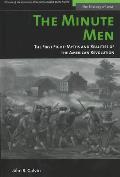“To be ready to act at a minute’s warning”
The minute man (or minuteman) has become an icon of the American Revolution, especially in New England.
Indeed, the term was invented just before the outbreak of war as a response to the population’s growing rift with the royal government.
The concept had deeper roots. As John R. Galvin showed in The Minute Men, the Massachusetts militia system had a tradition of developing companies of men who could turn out quickly during emergencies, fully equipped and well trained. A 1645 regulation told company commanders to choose thirty out of a hundred men “who shall be ready at half an hour’s warning.”
Other seventeenth-century wartime laws spoke of “a day’s warning” and “an hour’s warning,” based on the proximity of the danger. In 1675, as the conflict later named King Philip’s War broke out, a document spoke of militiamen “ready to march on a moment’s warning.”
In August 1774 the Massachusetts Government Act arrived from London, rewriting the colony’s constitution from above. This provoked widespread resistance in the countryside, with crowds forcing magistrates not to open the courts and driving royal appointees away. The militancy grew worse after the “Powder Alarm” of 1–2 September.
In those months, Worcester County towns were holding a series of conventions. The 21 September gathering issued a call for towns to reorganize their militia units to remove officers who accepted the Massachusetts Government Act. Another part of that call proposed that “each town of the county...enlist one third of the men of their respective towns, between sixteen and sixty years of age, to be ready to act at a minute’s warning.”
Within three weeks, on 5 October, the Boston merchant John Andrews told a relative in Philadelphia that Worcester County towns had “incorporated seven regiments” who “turn out twice a week to perfect themselves in the military art—which are call’d minute men, i.e., to be ready at a minute’s warning with a fortnight’s provision, and ammunition and arms.”
That phrasing shows that Andrews’s contemporaries were starting to use the term “minute men,” but it was still new enough to need explaining.
On 7 October, the Massachusetts Provincial Congress convened as a shadow legislature stepping into the vacuum of government outside Boston. About three weeks later that body started to organize a military force under its committee of safety. Among the steps the congress recommended to town militia companies was that officers
Nonetheless, the provincial congress issued its resolutions as recommendations, not requirements. The authority of town governments was firmer than its own, and this was supposed to be a bottoms-up rebuilding of a legitimate government. Thus, it was up to each town to decide whether to establish minute companies and how to define them.
TOMORROW: How that played out in Westborough.
Indeed, the term was invented just before the outbreak of war as a response to the population’s growing rift with the royal government.
The concept had deeper roots. As John R. Galvin showed in The Minute Men, the Massachusetts militia system had a tradition of developing companies of men who could turn out quickly during emergencies, fully equipped and well trained. A 1645 regulation told company commanders to choose thirty out of a hundred men “who shall be ready at half an hour’s warning.”
Other seventeenth-century wartime laws spoke of “a day’s warning” and “an hour’s warning,” based on the proximity of the danger. In 1675, as the conflict later named King Philip’s War broke out, a document spoke of militiamen “ready to march on a moment’s warning.”
In August 1774 the Massachusetts Government Act arrived from London, rewriting the colony’s constitution from above. This provoked widespread resistance in the countryside, with crowds forcing magistrates not to open the courts and driving royal appointees away. The militancy grew worse after the “Powder Alarm” of 1–2 September.
In those months, Worcester County towns were holding a series of conventions. The 21 September gathering issued a call for towns to reorganize their militia units to remove officers who accepted the Massachusetts Government Act. Another part of that call proposed that “each town of the county...enlist one third of the men of their respective towns, between sixteen and sixty years of age, to be ready to act at a minute’s warning.”
Within three weeks, on 5 October, the Boston merchant John Andrews told a relative in Philadelphia that Worcester County towns had “incorporated seven regiments” who “turn out twice a week to perfect themselves in the military art—which are call’d minute men, i.e., to be ready at a minute’s warning with a fortnight’s provision, and ammunition and arms.”
That phrasing shows that Andrews’s contemporaries were starting to use the term “minute men,” but it was still new enough to need explaining.
On 7 October, the Massachusetts Provincial Congress convened as a shadow legislature stepping into the vacuum of government outside Boston. About three weeks later that body started to organize a military force under its committee of safety. Among the steps the congress recommended to town militia companies was that officers
enlist one quarter, at the least, of the number of the respective companies, and form them into companies of fifty privates, at the least, who shall equip and hold themselves in readiness, on the shortest notice from the said committee of safety, to march to the place of rendezvous.That official act didn’t specify a “minute,” but by November the congress was using the term “minute men” for these companies.
Nonetheless, the provincial congress issued its resolutions as recommendations, not requirements. The authority of town governments was firmer than its own, and this was supposed to be a bottoms-up rebuilding of a legitimate government. Thus, it was up to each town to decide whether to establish minute companies and how to define them.
TOMORROW: How that played out in Westborough.


No comments:
Post a Comment